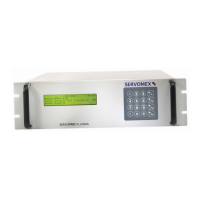User Manual SERVOPRO PLASMA Trace N
2
Analyzer
APPENDIX 1 56
2.0 Selection of material
2.1 Introduction
Special care must be taken in selecting the distribution equipment that will remove the gas from
the cylinder and transport it to the analytical instrumentation.
Bad selection of equipment can result in unwanted oxygen, nitrogen or moisture diffusing into
the system. Outgassing of monomers and dimers from an elastomer can result in system drift and
instability. For example, outgassing from neoprene diaphragms in a pressure reducing regulator
can cause excessive drift.
For maintaining gas purity stainless steel is preferred, since oxygen, nitrogen and water do not
adsorb into steel as much they adsorb in copper. Furthermore, as an option, you can have
stainless steel degreased and passivated . This process removes all traces of oil, grease and dirt,
thus ensuring optimal performance.
For all your gas lines and pressure regulators, stream selection valves and fittings, use stainless
steel. The use of pipe thread fittings is not recommended by Servomex, and the performance of
the analyzer is not guaranteed under this condition of use.
2.2 Pressure regulators selection
Industrial general purpose regulators are often constructed with either Buna-N or neoprene
diaphragms. You must not use this type of regulators in analytical systems. Both Buna-N and
neoprene are permeable to oxygen.
The only type of pressure regulator that we recommend is the one found at the end of this
application note. Any real equivalent will be acceptable.
2.3 Sample lines selection
From the outlet of the pressure regulator you must use a stainless steel line. Stainless steel lines
of 1/8" diameter, clean and passivated are commercially available at moderate cost. No other
material is approved by Servomex. Plastic tubing often found in older air separation plants is
absolutely not recommended. These types of tubing are permeable to oxygen, nitrogen and
moisture.

